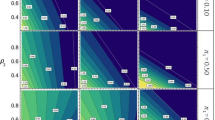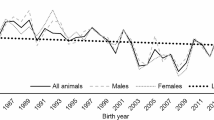Abstract
A major issue faced by breeders is how to effectively manage adverse correlations in breeding programs. We present results of a Monte Carlo allele-based simulation of the changes in response and variance of response under adverse genetic correlations by using the examples of two contrasting selection methods: the ‘Smith-Hazel’ selection index (SH) and independent culling (IC). We assumed several gene models, which included linkage and antagonistic pleiotropy as the primary drivers of adverse genetic correlations. The different behaviors of these selection methods allowed us to identify the mechanism behind the generation of uncertainty under antagonistic trait selection: IC had the properties of stabilizing selection, while SH behaved more similar to disruptive selection. Although SH outperformed IC in terms of genetic gain, this advantage happened at the cost of higher variance of response and loss of heterozygosity. Using an optimum selection algorithm (OS) to prevent the loss of heterozygosity through a constraint on inbreeding in SH/OS increased marginally the reliability, remaining still below that of IC under equal conditions. However, SH/OS had lower inbreeding (ΔF) than IC for equivalent levels of genetic gain, so a compromise between high selection reliability, low ΔF, and gain must be made by a breeder under antagonistic trait selection even with the use of optimization tools.





Similar content being viewed by others
References
Barton NH (1990) Pleiotropic models of quantitative variation. Genetics 124:773–782
Bennett GL, Swiger LA (1980) Genetic variance and correlation after selection for two traits by index, independent culling levels and extreme selection. Genetics 94:763–775
Brisbane JR, Gibson JP (1995) Balancing selection response and rate of inbreeding by including genetic relationships in selection decisions. Theor Appl Genet 91:421–431
Bulmer M (1985) The mathematical theory of quantitative genetics. Clarendon, Oxford
Caballero A (1989) Efficiency in prediction of response in selection index experiments. J Anita Breed Genet 106:187–194
Campo JL, Rodriguez C (1986) Experimental comparison of methods for simultaneous selection of two correlated traits in Tribolium. 2. Index selection and independent culling levels: a replicated single generation test. Genet Sel Evol 18:431–445
Conner JK (2002) Genetic mechanisms of floral trait correlations in a natural population. Nature 420:407–410
Doolittle DP, Wilson SP, Hulbert LL (1972) A comparison of multiple trait selection methods in the mouse. J Heredity 63:366–372
Eagles HA, Frey KJ (1974) Expected and actual gains in economic value of oat lines from five selection methods. Crop Science 14:861–864
Elsik C, Williams CG (2002) Low-copy microsatellite recovery from a conifer genome. Theor Appl Genet 103:1189—1195
Finney DJ (1962) Genetic gains under three methods of selection. Genet Res 3:417–423
Gimelfarb A (1992) Pleiotropy and multilocus polymorphisms. Genetics 130:223–227
Hazel LN, Lush JL (1942) The efficiency of three methods of selection. J Heredity 33:393–399
Hedrick PW (1999) Antagonistic pleiotropy and genetic polymorphism: a perspective. Heredity 82:126–133
Hill WG (1977) International Conference in Quantitative Genetics. In: Pollak E, Kempthorne O, Bailey TB (eds) Variation in response to selection. Iowa State University Press, Ames
Ieiri S, Nomura T, Hirooka H, Satoh M (2004) A comparison of restricted selection procedures to control genetic gains. J Anita Breed Genet 121:90–100
Kearsey MJ, Farquhar AGL (1998) QTL analysis in plants, where are we now? Heredity 80:137–142
King JN, Hansen J (1997) Cost-effective selection strategies in continued genetic improvement. In IUFRO Genetics of Radiata pine. FRI Bulletin no. 203. Rotorua, New Zealand, pp 192–198 (December 1997)
King JN, Yeh FC, Heaman JC, Dancik BP (1988) Selection of wood density and diameter in controlled crosses of coastal Douglas-fir. Silvae Genet 37:152–157
Lande R (1984) The genetic correlation between characters maintained by selection, linkage and inbreeding. Genet Res 44:309–320
Lynch M, Walsh B (1998) Genetics and analysis of quantitative traits. Sinauer Associates, Sunderland
Merilä J, Sheldon BC (1999) Genetic architecture of fitness and nonfitness traits: empirical patterns and development of ideas. Heredity 83:103–109
Meuwissen THE (1997) Maximizing the response of selection with a predefined rate of inbreeding. J Anim Sci 75:934–940
Nicholas F (1989) Incorporation of new reproductive technology in genetic improvement programmes. In: Hill WG, MacKay TFC (eds) Evolution and animal breeding. CAB International, Wallingford, Oxon, pp 203–209
Nomura T (1997) A simulation study on variation to response to selection and population size required for selection programs. J Anita Breed Genet 114:13–21
Nomura T, Yamaguchi S, Mukai F, Yamamoto A (2002) Optimization of selection and mating schemes in closed broiler lines. Anim Sci J 73:435–443
Press WH, Teukolsky SA, Vetterling WT, Flannery BP (1992) Numerical recipes in FORTRAN: the art of scientific computing. Cambridge University Press, Cambridge
Rendel JM (1963) Correlation between the number of scutellar and abdominal bristles in Drosophila melanogaster. Genetics 48:391–408
Roff DA (1997) Evolutionary quantitative genetics. Chapman & Hall, London
Sanchez L, Bijma P, Woolliams JA (2003) Minimizing inbreeding by managing genetic contributions across generations. Genetics 164:1589–1595
Sen BK, Robertson A (1964) An experimental examination of methods for the simultaneous selection of two characters using Drosophila melanogaster. Genetics 50:199–209
Sgrò CM, Hoffmann AA (2004) Genetic correlations, tradeoffs and environmental variation. Heredity 93:241–248
Stebbins GL (1971) Chromosomal evolution in higher plants. Edward Arnold, London
Villanueva B, Kennedy BW (1993) Index versus tandem selection after repeated generations of selection. Theor Appl Genet 85:706–712
Young SY (1961) A further examination of the relative efficiency of three methods of selection for genetic gains under less-restricted conditions. Genet Res 2:106–121
Zobel BJ, Jett JB (1995) Genetics of wood production. Springer, Berlin
Acknowledgements
The authors gratefully acknowledge support from Projets Innovants Funding Program of Département de Ecologie des Forêts, Prairies et milieux Aquatiques, INRA (LS), from Fonds France Canada pour la Recherche of French Embassy in Canada, and the British Columbia Ministry of Forestry in Canada (LS, AAY & JNK). We are grateful to two anonymous referees for comments on the manuscript.
Author information
Authors and Affiliations
Corresponding author
Additional information
Communicated by R. Johnson
Rights and permissions
About this article
Cite this article
Sánchez, L., Yanchuk, A.A. & King, J.N. Gametic models for multitrait selection schemes to study variance of response and drift under adverse genetic correlations. Tree Genetics & Genomes 4, 201–212 (2008). https://doi.org/10.1007/s11295-007-0101-5
Received:
Revised:
Accepted:
Published:
Issue Date:
DOI: https://doi.org/10.1007/s11295-007-0101-5




